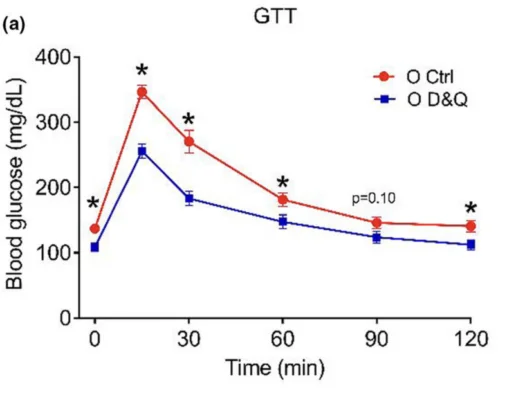Scientists have shown that a popular senolytic combination of dasatinib and quercetin improves glucose tolerance and fasting blood glucose levels in aged mice [1].
The question of metabolism
Cellular senescence is one of the hallmarks of aging, and senolytics, drugs that clear away senescent cells, have been shown to ameliorate some aging phenotypes. However, not a lot is known about the effect of senolytic treatment on metabolism. In this new study, the researchers tested the hypothesis that a treatment with the popular senolytic duo dasatinib and quercetin (D+Q) would improve metabolic function in old mice by alleviating the immune response that cellular senescence causes in adipose tissue.
Reduced weight changes and inflammation
The researchers used an intermittent treatment protocol: 21-month-old mice received D+Q on three consecutive days every two weeks for three months. The treatment was quite effective in removing senescent cells from white adipose tissue (WAT) almost to the levels of young controls. Interestingly, the senolytic effect was much less pronounced in two other metabolically active tissues: liver and muscle.
As to the outcomes, D+Q treatment almost completely ameliorated age-related changes in body weight and fat mass. Unlike the treated animals, old controls gained weight, lost subcutaneous fat, and acquired some perigonadal fat. The latter is basically visceral fat which is considered far more metabolically harmful than subcutaneous fat; therefore, the untreated animals during natural aging lost “good” fat and gained “bad” fat, but the treated did not.
Senescent cells trigger immune response by emitting the SASP (senescence-associated secretory phenotype), a mix of largely pro-inflammatory molecules. D+Q successfully reduced the levels of many SASP components in WAT, but again, much less so in liver and muscle. Given the meager senolytic effect achieved in those two tissues, in their subsequent experiments, the researchers focused on perigonadal white fat. They found that the treatment cut recruitment of T cells into WAT in half, and it reduced macrophage recruitment to the very low levels observed in young controls.
Improved metabolism, beyond aging
While in humans, fasting blood glucose levels and glucose tolerance decline progressively with age [2,3], they remained steady in the mice in this study. Still, D+Q treatment significantly improved both markers. Notably, the treated mice had much less pronounced post-meal glucose spikes, which are associated with accelerated aging. Improved glucose tolerance in the treated mice was associated with a decrease in production of glucose by the liver (hepatic gluconeogenesis). Excessive hepatic gluconeogenesis is a major contributor to hyperglycemia in Type 2 diabetes [4]. Histopathological analysis showed that the treatment alleviated an age-related increase in collagen deposition in the liver.

To examine the impact of D+Q on systemic lipid metabolism, the researchers measured fed and fasted plasma triglycerides. Here, too, no difference was recorded between young and old controls. However, plasma triglyceride levels were lowered by D+Q. Systemic lipid tolerance also did not show age-related dynamics but was improved by the treatment. Conversely, neither aging nor D+Q seemed to affect plasma total cholesterol, LDL, or HDL.
Although we did not observe an age-related difference in glucose tolerance, D&Q treatment improved fasting blood glucose (p = 0.001) and glucose tolerance (p = 0.007) in old mice that was concomitant with lower hepatic gluconeogenesis. Additionally, D&Q improved insulin-stimulated suppression of plasma NEFAs (p = 0.01), reduced fed and fasted plasma triglycerides (both p ≤ 0.04), and improved systemic lipid tolerance (p = 0.006). Collectively, results from this study suggest that D&Q attenuates adipose tissue inflammation and improves systemic metabolic function in old age. These findings have implications for the development of therapeutic agents to combat metabolic dysfunction and diseases in old age.
Conclusion
While senescent cells are important for organismal development, wound healing, and keeping cancer at bay, their age-related accumulation tips the scales towards damage [5], driving chronic inflammation, which affects metabolism. Senolytic drugs are being actively studied for various indications, but their effects on metabolism are often overlooked. This study suggests a link between senescent cells, inflammation, and metabolism, paving the road for similar studies in humans.
Literature
[1] Islam, M. T., Tuday, E., Allen, S., Kim, J., Trott, D. W., Holland, W. L., … & Lesniewski, L. A. (2023). Senolytic drugs, dasatinib and quercetin, attenuate adipose tissue inflammation, and ameliorate metabolic function in old age. Aging Cell, e13767.
[2] Chang, A. M., & Halter, J. B. (2003). Aging and insulin secretion. American Journal of Physiology-Endocrinology and Metabolism, 284(1), E7-E12.Chicago
[3] Ko, G. T., Wai, H. P., & Tang, J. S. (2006). Effects of age on plasma glucose levels in non-diabetic Hong Kong Chinese. Croatian medical journal, 47(5), 709-713.Chicago
[4] Sharabi, K., Tavares, C. D., Rines, A. K., & Puigserver, P. (2015). Molecular pathophysiology of hepatic glucose production. Molecular aspects of medicine, 46, 21-33.
[5] Huang, W., Hickson, L. J., Eirin, A., Kirkland, J. L., & Lerman, L. O. (2022). Cellular senescence: The good, the bad and the unknown. Nature Reviews Nephrology, 18(10), 611-627.





